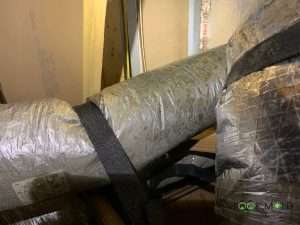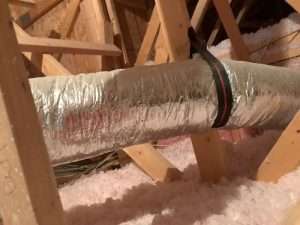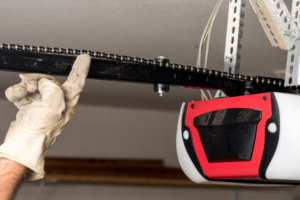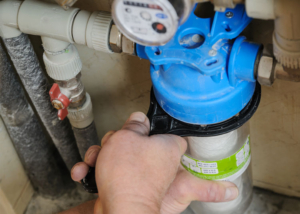Your HVAC Joint Tape Is Loose In Attic Area
If you have had a home inspection on a home that you purchased in Miami, FL, or other areas then you most likely hired a home inspector to perform a home inspection on the property prior to your purchasing the property. As a home inspector in Pembroke Pines, FL I have seen on numerous occasions that your HVAC joint tape is loose. When I or another home inspector see this it’s usually because there are some signs of possible biological growth or condensation in the area where the HVAC joint tape is loose in attic.
If your HVAC joint tape is loose in attic, looks like this below:

Duct tape is useful for repairing just about anything, but ironically, not for ducts. Although the name might be misleading, general-purpose duct tape was not designed for use in HVAC ductwork at all. In fact, if you tried using “regular” duct tape on your ductwork, it would more than likely fail and give you the results shown in the pictures.
HVAC ductwork without loose tape below:
Your HVAC Joint Tape Is Loose In Attic Area – Tape Types
Parts of the air delivery system that also require sealing with tape would include duct joints, seams, junctions, and the area where the ductwork meets the air vent. The main trunk line is the primary delivery system for conditioned air and will require tape for the smaller duct lines that branch off of it. Acrylic adhesives do an excellent job of forming a permanent bond, which is critical in HVAC applications. Due to the highly aggressive nature of this adhesive system, most tapes that use an acrylic adhesive must also have a liner to prevent the tape from permanently sticking to itself once it is in a rolled format.
HVAC join tape differences in adhesive systems:
- Rubber: Whether natural or synthetic, rubber adhesive systems offer good tack and adhesion to a variety of surfaces, but will not perform well in colder temperatures, especially if it reaches below the freezing point of 32 degrees Fahrenheit.
- Butyl: A specialized rubber adhesive system, butyl tapes are extremely durable, have good flex properties and are often used in applications where an airtight bond is required. Tapes with butyl adhesive systems offer a service temperature – the temperature a tape may experience once it’s been applied – ranges from -20 degrees Fahrenheit to 200 degrees Fahrenheit, so they can be used where the temperature varies after application, like an unconditioned attic. Application temperatures – the temperature during which the tape is used – are a bit more limiting. Butyl tapes should only be applied when temperatures are between 35 degrees Fahrenheit and 110 degrees Fahrenheit. Many butyl tapes also come with a liner since the adhesive system is aggressive and forms a permanent bond to the surface it sticks to – even if that surface is itself!
- Acrylic: Offering a good balance of adhesion, shear, and tack, tapes with acrylic adhesive systems are resistant to thermal and UV degradation. They can be used on many surfaces and perform in a much wider application temperature range – typically anywhere from -30 degrees Fahrenheit to 300 degrees Fahrenheit. Acrylic adhesives do an excellent job of forming a permanent bond, which is critical in HVAC applications. Due to the highly aggressive nature of this adhesive system, most tapes that use an acrylic adhesive must also have a liner to prevent the tape from permanently sticking to itself once it is in a rolled format.
Adhesiveness is just one factor that should be taken into account when selecting a tape. Tape characteristics like backing, strength, and permeability are a few other factors that can impact the job.
- Increased energy bills. Have you noticed an increase in your energy bills? …
- Hot and cold spots.
- Dust around your home.
- Run your HVAC system at full blast.
- Look for apparent leaks.
- Check to see if there’s duct tape.
- Pay attention to the duct joints.
- Use incense or a smoke pencil.
Five Reasons to Fix Your HVAC Joint Tape
- Comfort
- Indoor Air Quality
- Safety
- Save Money
- Protect the Environment
Your HVAC Joint Tape Is Loose In Attic Area – Repair Video
Check out this video on youtube on How to Air Seal Ductwork
If you have additional questions and you want to get in contact with GGR Home Inspections please send us a note, text, or call.








Pingback: Shop for a Home with these 4 Major Components in Mind – GGR Home Inspections